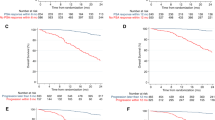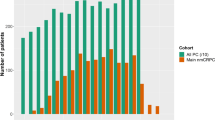Abstract
Background:
The optimal management of men with PSA failure following initial prostate cancer (PC) therapy stratified by comorbidity is unknown. We investigated the impact that PSA doubling time (DT) and comorbidity had on the risk of all-cause mortality (ACM), prostate cancer-specific mortality (PCSM) and other-cause mortality (OCM) following PSA failure.
Methods:
Between 1995 and 2001, 206 men with unfavorable-risk PC were randomized to receive radiation therapy alone or in combination with 6 months of androgen deprivation therapy (ADT); 108 men experienced PSA failure and formed the study cohort. Cox and Fine–Gray regression analysis was used to determine whether PSA DT was associated with the risk of ACM and PCSM/OCM, respectively, stratified by comorbidity status using a validated metric.
Results:
After a median follow-up of 13.71 years following PSA failure, 81 of the 108 men (75%) died. Longer PSA DT was associated with a decreased risk of PCSM in men with no/minimal (adjusted hazard ratio (AHR) 0.33, 95% confidence interval (CI) 0.17–0.65, P=0.001) and moderate/severe comorbidity (AHR 0.014, 95% CI 0.002–0.129, P=0.0002). However, because of the different contributions of the risk of OCM to risk of ACM within comorbidity subgroups, increasing PSA DT was only associated with a decreased risk of ACM in men with no/minimal (AHR 0.69, 95% CI 0.50–0.96, P=0.03) but not moderate/severe comorbidity (AHR 0.95, 95% CI 0.51–1.78, P=0.87).
Conclusions:
Both the extent of comorbidity and the PSA DT should be taken into consideration when deciding on appropriate management and/or clinical trial eligibility at the time of PSA failure.
This is a preview of subscription content, access via your institution
Access options
Subscribe to this journal
Receive 4 print issues and online access
$259.00 per year
only $64.75 per issue
Buy this article
- Purchase on Springer Link
- Instant access to full article PDF
Prices may be subject to local taxes which are calculated during checkout


Similar content being viewed by others
References
D’Amico AV, Whittington R, Malkowicz SB, Schultz D, Kaplan I, Beard CJ et al. Biochemical outcome after radical prostatectomy, external beam radiation therapy, or interstitial radiation therapy for clinically localized prostate cancer. JAMA 1998; 280: 969–974.
Freedland SJ, Humphreys EB, Mangold LA, Eisenberger M, Dorey FJ, Walsh PC et al. Risk of prostate cancer-specific mortality following biochemical recurrence after radical prostatectomy. JAMA 2005; 294: 433–439.
D’Amico AV, Moul JW, Carroll PR, Sun L, Lubeck D, Chen MH . Surrogate end point for prostate cancer-specific mortality after radical prostatectomy or radiation therapy. J Natl Cancer Inst 2003; 95: 1376–1383.
Wo JY, Chen MH, Nguyen PL, Renshaw AA, Loffredo MJ, Kantoff PW et al. Evaluating the combined effect of comorbidity and prostate-specific antigen kinetics on the risk of death in men after prostate-specific antigen recurrence. J Clin Oncol 2009; 27: 6000–6005.
Piccirillo JF, Tierney RM, Costas I, Grove L, Spitznagel EL . Prognostic importance of comorbidity in a hospital-based cancer registry. JAMA 2004; 291: 2441–2447.
Martin NE, Chen MH, Beard CJ, Nguyen PL, Loffredo MJ, Renshaw AA et al. Natural history of untreated prostate specific antigen radiorecurrence prostate cancer in men with favorable prognostic indicators. Prostate Cancer 2014; 2014: 912943.
D’Amico AV, Denham JW, Crook J, Chen MH, Goldhaber SZ, Lamb DS et al. Influence of androgen suppression therapy for prostate cancer on the frequency and timing of fatal myocardial infarctions. J Clin Oncol 2007; 25: 2420–2425.
Keating NL, O’Malley AJ, Smith MR . Diabetes and cardiovascular disease during androgen deprivation therapy for prostate cancer. J Clin Oncol 2006; 24: 4448–4456.
Tannock IF, de Wit R, Berry WR, Horti J, Pluzanska A, Chi KN et al. Docetaxel plus prednisone or mitoxantrone plus prednisone for advanced prostate cancer. New Engl J Med 2004; 351: 1502–1512.
Petrylak DP, Tangen CM, Hussain MH, Lara PN, Jones JA, Taplin ME et al. Docetaxel and estramustine compared with mitoxantrone and prednisone for advanced refractory prostate cancer. New Engl J Med 2004; 351: 1513–1520.
de Bono JS, Logothetis CJ, Molina A, Fizazi K, North S, Chu L et al. Abiraterone and increased survival in metastatic prostate cancer. New Engl J Med 2011; 364: 1995–2005.
Beer TM, Armstrong AJ, Rathkopf DE, Loriot Y, Sternberg CN, Higano CS et al. Enzalutamide in metastatic prostate cancer before chemotherapy. New Engl J Med 2014; 371: 424–433.
Roach M, Hanks G, Thames H, Schellhammer P, Shipley WU, Sokol GH et al. Defining biochemical failure following radiotherapy with or without hormonal therapy in men with clinically localized prostate cancer: recommendations of the RTOG-ASTRO Phoenix Consensus Conference. Int J Radiat Oncol Phys 2006; 65: 965–974.
American Society for Therapeutic Radiology and Oncology Consensus Panel. Consensus statement: guidelines for PSA following radiation therapy. Int J Radiat Oncol Biol Phys 1997; 37: 1035–1041.
Agresti A . Categorical Data Analysis, 2nd edn. John Wiley & Sons: Hoboken, NJ, 2002.
Greene FL, Page DL, Fleming ID, Fritz AG, Balch CM, Haller DG et al (eds). AJCC Cancer Staging Manual, 6th edn. Springer: New York, NY, 2002.
Hollander M, Wolfe DA, Chicken E . Nonparametric Statistical Methods, 3rd edn. John Wiley & Sons: Hoboken, NJ, 2013.
Fisher RA . On the interpretation of X2 from contingency tables, and the calculation of P. J R Stat Soc 1922; 85: 87–94.
Klein J, Moeschberger M (eds). Semiparametric Proportional Hazards Regression with Fixed Covariates: Survival Analysis, Techniques for Censored and Truncated Data, 2nd. ednSpringer: New York, NY, 2003; pp 243–293.
Fine JP, Gray RJ . A proportional hazards model for the sub distribution of a competing risk. J Am Stat Assoc 1999; 94: 496–509.
D’Amico AV, Chen MH, Renshaw AA, Loffredo M, Kantoff PW . Androgen suppression and radiation vs radiation alone for prostate cancer: a randomized trial. JAMA 2008; 299: 289–295.
Klein J, Moeschberger M (eds). Refinements of the Semiparametric Proportional Hazards Model, Survival Analysis, Techniques for Censored and Truncated Data, 2nd edn. Springer: New York, NY, 2003; pp 295–328.
Kaplan EL, Meier P . Nonparametric estimation from incomplete observations. J Am Stat Assoc 1958; 53: 457–500.
Gaynor JJ, Feuer EJ, Tan CC, Wu DH, Little CR, Straus DJ et al. On the use of cause-specific failure and conditional failure probabilities: examples from clinical oncology data. J Am Stat Assoc 1993; 88: 400–409.
Cupples LA, Gagnon DR, Ramaswamy RB . Age-adjusted survival curves with application in the Framingham Study. Stat Med 1995; 14: 1731–1744.
Mantel N . Evaluation of survival data and two new rank order statistics arising in its consideration. Cancer Chemother Rep 1966; 50: 163–170.
Gray RJ . A class of K-sample tests for comparing the cumulative incidence of a competing risk. Ann Stat 1988; 16: 1141–1154.
Bland JM, Altman DG . Multiple significance tests: the Bonferroni method. Br Med J 1995; 310: 170.
Freedland SJ, Humphreys EB, Mangold LA, Eisenberger M, Dorey FJ, Walsh PC et al. Death in patients with recurrence prostate cancer after radical prostatectomy: prostate-specific antigen doubling time subgroups and their associated contributions to all-cause mortality. J Clin Oncol 2007; 25: 1765–1771.
D’Amico AV, Moul J, Carroll PR, Sun L, Lubeck D, Chen MH . Prostate specific antigen doubling time as a surrogate end point for prostate cancer specific mortality following radical prostatectomy or radiation therapy. J Urol 2004; 172: S42–S46.
Denham JW, Steigler A, Wilcox C, Lamb DS, Joseph D, Atkinson C et al. Time to biochemical failure and prostate-specific antigen doubling time as surrogates for prostate cancer-specific mortality: evidence from the TROG 96.01 randomised controlled trial. Lancet Oncol 2008; 9: 10–58-68.
Parker C, Nilsson S, Heinrich D, Helle SI, O’Sullivan JM, Fossa SD et al. Alpha emitter radium-223 and survival in metastatic prostate cancer. N Eng J Med 2013; 369: 213–223.
de Bono JS, Oudard S, Ozguroglu M, Hansen S, Machiels JP, Kocak I et al. Prednisone plus cabazitaxel or mitoxantrone for metastatic castration-resistant prostate cancer progressing after docetaxel treatment: a randomized open-label trial. Lancet 2010; 376: 1147–1154.
Kantoff PW, Higano CS, Shore ND, Berger ER, Small EJ, Penson DF et al. Sipuleucel-T immunotherapy for castration-resistant prostate cancer. N Engl J Med 2010; 363: 411–422.
Mateo J, Carreira S, Sandhu S, Miranda S, Mossop H, Perez-Lopez R et al. DNA-repair defects and olaparib in metastatic prostate cancer. N Engl J Med 2015; 373: 1697–1708.
D’Amico AV, Chen MH, Renshaw A, Loffredo M, Kantoff PW . Long-term follow-up of a randomized trial of radiation with or without androgen deprivation therapy for localized prostate cancer. JAMA 2015; 314: 1291–1293.
Deeks SG, Lewin SR, Havlir DV . The end of AIDS: HIV infection as a chronic disease. Lancet 2013; 382: 1525–1533.
Wang A, Obertova Z, Brown C, Karunasinghe N, Bishop K, Ferguson L et al. Risk of fracture in men with prostate cancer on androgen deprivation therapy: a population-based cohort study in New Zealand. BMC Cancer 2015; 15: 837.
Author information
Authors and Affiliations
Corresponding author
Ethics declarations
Competing interests
The authors declare no conflict of interest.
Rights and permissions
About this article
Cite this article
Patel, S., Chen, MH., Loffredo, M. et al. The impact of comorbidity and PSA doubling time on the risk of death in men experiencing PSA failure following radiation therapy with or with androgen deprivation therapy for unfavorable-risk prostate cancer. Prostate Cancer Prostatic Dis 20, 234–240 (2017). https://doi.org/10.1038/pcan.2016.74
Received:
Revised:
Accepted:
Published:
Issue Date:
DOI: https://doi.org/10.1038/pcan.2016.74



